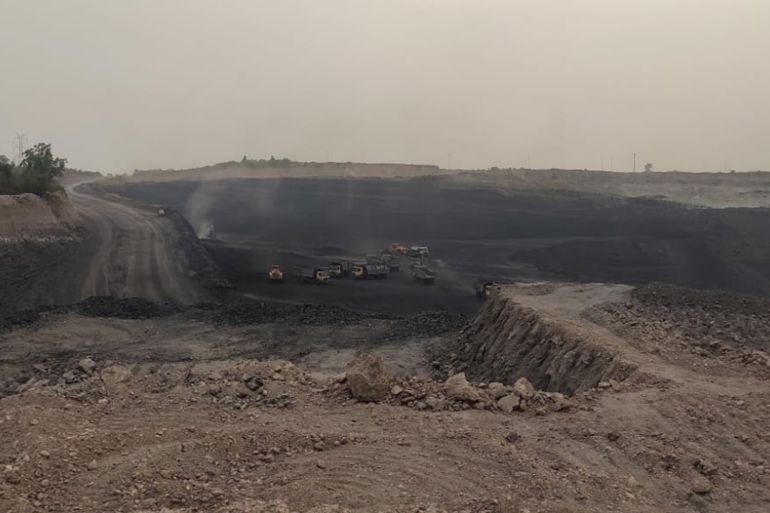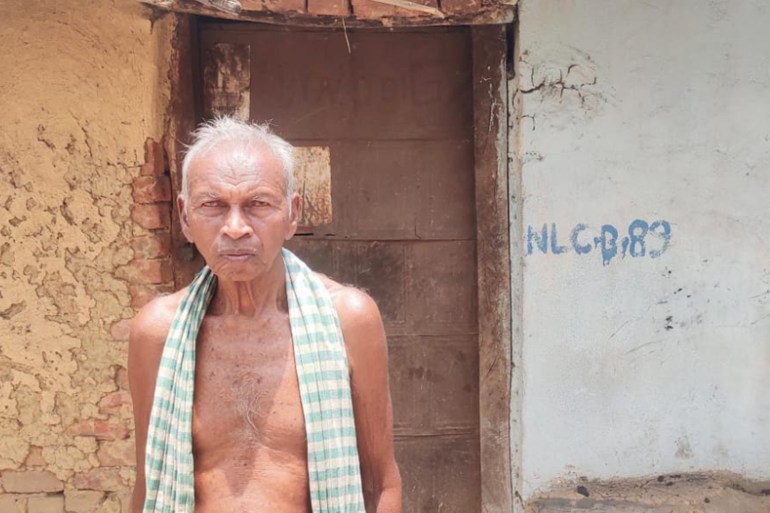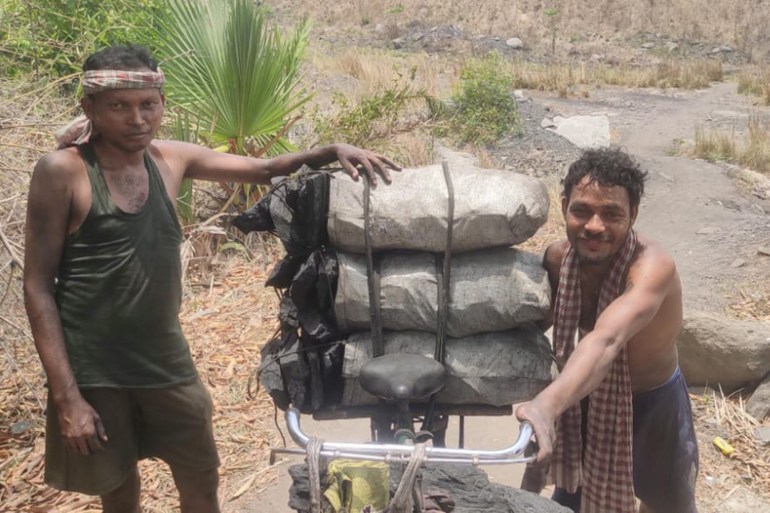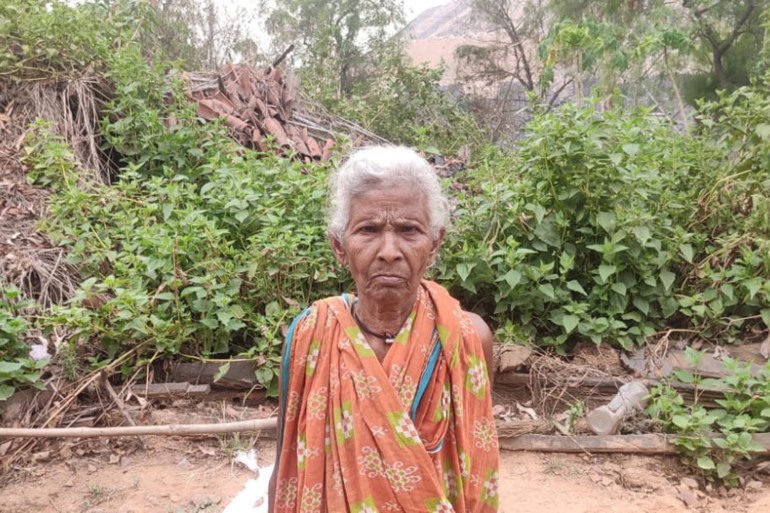As Adani steps up mining, villagers to be displaced third time
Hundreds fear displacement for the third time in India’s Odisha state as coal mining is set to start.

Sambalpur, India – Nityananda Deep has worried about losing his home for the third time in his life ever since his mud house was marked for demolition by mining officials, about a year ago.
The 80-year-old is a resident of remote Behermunda Hamlet in Sambalpur district in the southern Indian state of Odisha, about four hours drive from the capital Bhubaneswar.
Keep reading
list of 4 itemsLocals blame coal power plant in Maharashtra for death, sickness
Coal, oil price surges on Ukraine war make Asia’s richest richer
Parched villages in India coal-mining hubs hunt for scarce water
The first time Deep was displaced was when a dam was built in the area in 1957. He and his family moved three kilometres (1.8 miles) away to a two-acre plot that the government gave them where they grew paddy and vegetables.
The family was once again evicted in 2005 when their land was allocated for a coal mine, the Talabira coal mine block-I, and they moved to a barren plot about a kilometre (0.62m) away, he says.
Now Deep and his family of 13 are once again facing displacement as the government plans to expand mining in the area. “Now where do we go?” asks Deep, his voice shaky with age.
The septuagenarian is not alone. Some 30 households in the hamlet of 300 people will be displaced for the third time.
The villagers are part of the 1,894 families – 9,467 people – in six villages who face displacement for the Talabira coal blocks II and III in the Sambalpur and Jharsuguda districts.

Indian billionaire Gautam Adani’s enterprise owns Talabira-I and has the rights to mine the other two blocks.
The move to step up mining comes on the heels of the early start of a hotter than expected summer with an increase in demand loading power lines and coal stocks running low, leading to calls to dig and import more coal.
But experts say that with an estimated allocated coal reserve of 1.5 million tonnes, India doesn’t really have a coal shortage and there is no need for new coal blocks.
“The country has enough coal blocks operational for mining and most of them are still not mined till capacity,” said Nandikesh Sivalingam, director of the Centre for Research on Energy and Clean Air, a non-profit think-tank. The problem, he says, is a combination of poor planning and fiscal issues that has prevented the coal from getting to where it is needed in time.
“New investments should be focused on improving efficiency of the sector and not on creating new power plants or coal mines. Green cover should not be unnecessarily destroyed for the sake of opening new coal blocks when it’s not required,” he said.
‘Thieves on our own land’
Talabira coal block-I was allocated to Hindalco Industries, which operated it from 2005 until 2014, when India’s top court cancelled the mining licenses of 218 coal blocks, including Talabira-I, after it declared them illegal. In 2015 the government gave the block to another private company, GMR Chhattisgarh Energy Ltd, that had to stop mining in 2018 when its approval expired. In 2019 the Adani Group bought out that company and renamed it Raipur Energen Limited. It’s yet to start mining here.
When the coal block was allocated to Hindalco, some 69 hectares (170 acres) of land were taken away for mining, including 50 hectares (123 acres) of forest which was rich with mango, sal and medicinal trees that were used for making natural medicines, said Damru Rohi Das, 40, a resident of Behermunda Hamlet who depended on that work for his livelihood.
Das says he was offered 140,000 rupees ($1,800) per acre, an amount he calls “a pittance”.
The government also offered jobs to those who had lost both land and their house. Since Das had lost only his land, there was no job offer for him and he turned to doing menial jobs in agricultural fields to earn a living, he told Al Jazeera.
Once the mining was halted on court orders in 2014, Das switched to extracting coal from the closed Talabira-I mine to sell to make ends meet – but he has been accused of stealing the coal, he said.
Das and other villagers like Kartik Rohi Das (the two are not related) go to the mines at 4am to avoid getting caught by the police. Once they dig out the coal using shovels and their hands, they load it up, 100kg (220 pounds) on average, onto their bicycles and peddle 20 to 25km (12-15m) to sell to small eatery owners and households that still use coal for cooking. That work fetches them an average daily income of 250-300 rupees ($3.18-$3.81), says Rohi Das.
“But we are often harassed by the cops and company officials who take us to the police station and detain us for several hours,” he added. “We are labelled as thieves and accused of coal pilferage. It is so painful to face such humiliation for the land that was once owned by us.”

Mining in Talabira-II and III
In 2016 the mining lease for Talabira-II and III was granted to NLC India Limited (NLCIL) a Chennai-based government-owned company, to supply coal to Neyveli Talabira Thermal Power Plant in Tamil Nadu and the National Thermal Power Corporation in Odisha.
In 2018, Talabira (Odisha) Mining Private Limited, a subsidiary of Adani Enterprises, won the rights to extract coal or became a “mine developer and operator” for both the blocks. The operator contractor carries out all activities on behalf of the company that has the mining lease, from planning and development of the mine, to coal extraction and transportation, all for a contractually agreed fixed fee.
Together, the two coal blocks are estimated to have reserves of 553.98 million tonnes of coal and have a production capacity of 20 metric tonnes per annum.
For the two blocks the government has earmarked 1,914.063 hectares (4,729 acres) across the six villages, including 1,038.187 hectares (2,565 acres) of forest land, 457.078 hectares (1,129 acres) of agricultural land.
‘Forged’ permits and pressure tactics
Under Indian law, 75 percent of residents of the project area need to approve it before any mining can begin. Mining in Talabira-II (and in Talabira-III when that starts) is being done using consent that was given in 2012, said Dilip Sahu, a social activist in the area. He adds that even the signatures on that approval list had been forged, saying the handwriting on most signatures is the same.
“We have evidence to prove that forgery has been committed,” said Sahu. A lack of funds has held up their plans to file a court case on the matter, he said.
NLCIL officials declined to respond to Al Jazeera’s questions about whether they were aware of the allegations that the approval was forged.
Villagers living close to Talabira-II complain that the waste generated from opencast mining is being dumped in huge quantities in their fields in order to push them to vacate their land or sell it to the mining company at throwaway prices.
Khirod Chandra Pradhan, 45, from Patrapalli, one of the six villages impacted by this project, is one of many who sold his land a couple of months ago as the soil quality deteriorated because of the waste dumping.
His plot, roughly 0.4 hectares (one acre), fetched him 2.6 million rupees ($33,414), which, he says, is not a fair price and he was forced to sell his land recently because of the waste being dumped on it. “We are not against development but we need proper compensation, houses and livelihood opportunities to survive,” he said.
Villagers also complain of frequent “earthquake-like jolts” every time the mine operator uses explosives to dig deeper into the earth and which have put their lives in jeopardy and left their homes covered in cracks.
“We rush outside of our houses every day when the siren blows” to warn them of the blasting, said Chanchala Boghar, 80, a widow from Talabira village who had a narrow escape recently when her hut was knocked down by the impact of the blasting when she was outside.
The area is also part of the Ib valley which was identified as a severely polluted area as per the Comprehensive Environmental Pollution Index due to several coal mines in the area.

NCLIC refutes allegations
The NCLIC officials rebutted the allegations made by the villagers while employees of Adani enterprises declined to speak on the matter saying that they were only the contractors working for NCLIC.
A senior official at NCLIC, who requested anonymity as he was not authorised to speak to the media, said the company follows “most of the environmental rules” and dumps extracted debris only on land that has already been purchased. He added that the company pays compensation as per government norms and also offers a monthly allowance of 3,000 rupees ($38.3) to every adult in a family that has lost its land and house to the mining and is not able to get a job in the mining company. The amount will increase by 500 rupees ($6.39) after every two years, he said.
“We have offered jobs to around 300 locals [in the mining project] and we are creating jobs in a phase-wise manner whenever there are vacancies,” the official said adding that a power plant was in the works and would lead to more jobs in the area.
On a recent June evening Deep, whose home will be demolished for Talabira-II, sat near the abandoned mine worrying about the career options for his grandson. “The coal block has already turned the youths of our village into coal thieves who are regularly harassed by the administration but I do not want my grandson to meet a similar fate,” he said.
“I want him to study. But his future seems dark once we become homeless again.”